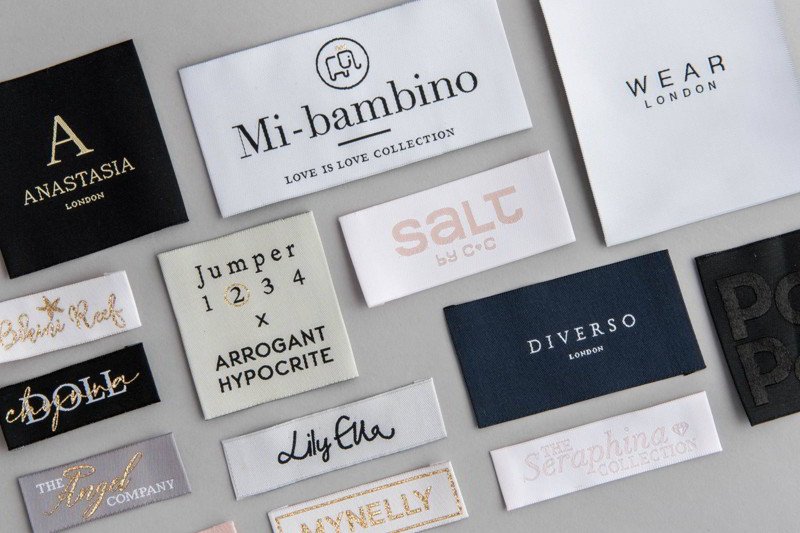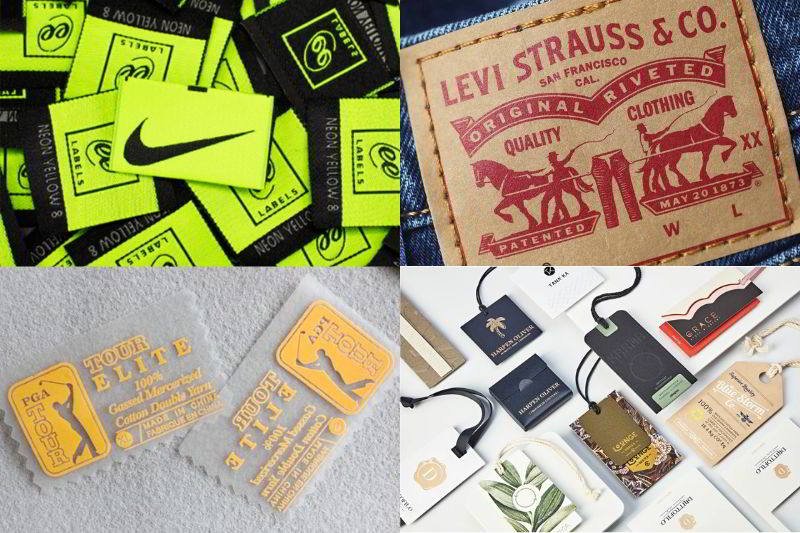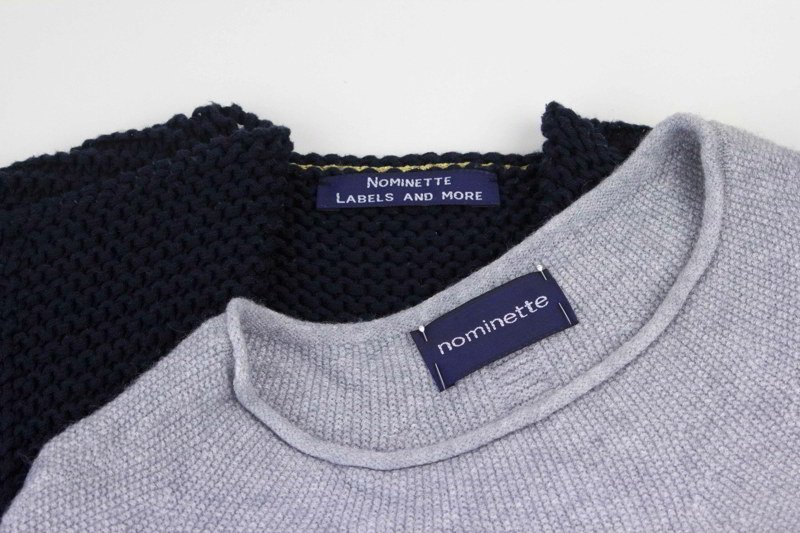Clothing Labels Explained: Brand Identity And Types
For emerging clothing businesses, establishing a distinct brand presence can feel like a significant hurdle. Understanding the role of a brand label is crucial, yet often overlooked amidst the pressures of design and production.
This guide demystifies brand labels, explaining their importance for product identification and building brand recognition. Readers will discover the essential functions of apparel branding, explore the different types of clothing labels available (from classic woven labels to versatile printed labels), and learn how these small elements contribute significantly to shaping a strong brand identity.
This resource provides foundational knowledge for any apparel entrepreneur aiming to make their mark.
1. Why brand labels are essential for your apparel brand’s success
Integrating brand labels into apparel is not merely a finishing touch; doing so is fundamental to building a successful business in the competitive fashion industry. These labels serve several critical functions:
- Establishing brand identity: The label is often the primary carrier of your visual brand identity, featuring the logo and name. Consistent use reinforces recognition and helps customers connect the physical garment with your specific brand.
- Projecting professionalism: A well-designed, quality label signals professionalism. This detail enhances the consumer perception of the garment, suggesting higher quality and attention to detail compared to unlabelled or poorly labelled items.
- Enhancing quality perception: The material and finish of the label itself contribute to the overall quality perception. A thoughtfully chosen label can elevate the perceived value of the apparel.
- Facilitating differentiation: In a crowded marketplace, a unique brand label is a key point of differentiation. The label helps customers distinguish your products from competitors quickly and easily.
- Building customer trust: A clear brand label acts as a mark of authenticity and accountability. This transparency builds customer trust and reinforces the brand promise associated with your products.
- Serving as a subtle marketing tool: Every time a labelled garment is worn or seen, the label provides ongoing brand visibility. While subtle, this consistent exposure functions as a continuous marketing tool, reinforcing brand recall long after the initial purchase.
- Aiding product identification: Beyond branding, labels simplify identification for both retailers during stocking and customers when repurchasing or recommending.

2. Decoding your brand label: Key information it carries
While design possibilities are vast, the core function of a brand label revolves around conveying essential identification information. The primary elements usually include:
- Logo: The visual symbol representing the brand. The logo is key for immediate identification and visual recall.
- Brand name: The textual name of the company or collection. The brand name provides clear representation and reinforces the brand identity alongside the logo.
- Distinction: The overall design and quality serve to distinguish the brand. While crucial details like washing instructions (care labels), garment size labels, and material composition are often required by law, these are typically placed on separate labels or sometimes combined onto larger printed labels or heat transfers to avoid cluttering the main brand identifier. The primary brand label focuses purely on branding.
2.1 Sew-in fabric labels
These are traditional labels attached by sewing them onto the garment. Two primary types dominate this category:
Woven labels
Woven labels are created by weaving threads together on a loom, resulting in a label with inherent texture and excellent durability. Characteristics include a premium feel, longevity (resisting fading better than print), and a classic aesthetic often associated with higher perceived quality.
Common materials influence the final look: damask offers the finest detail and high density, satin provides a softer feel with a noticeable sheen, and taffeta is a more basic, economical option. Woven labels are ideal for neck labels in shirts and outerwear, branding accessories, and applications where durability is paramount.
Potential drawbacks include potentially higher minimum order quantities (low minimum quantities might be harder to find compared to printed) and limitations on extremely intricate, photographic detail achievable with printing. They remain a standard for apparel branding and manufacturer tags.
Printed labels
Printed labels involve applying ink directly onto a fabric base, such as satin, cotton, or nylon. This method allows for exceptional detail clarity and vibrant, full-color designs, including gradients and photographic elements that are difficult to weave.
Characteristics include a smooth surface and often greater cost-effectiveness, especially for complex designs or smaller quantities. Satin labels offer a smooth, slightly shiny finish, while cotton labels provide a natural, matte look.
Printed labels are versatile, suitable for t-shirts, intricate logos, combining brand/care info onto a single label, and achieving a softer feel sometimes preferred for items worn close to the skin (mimicking a tagless label feel without being truly tagless). The primary consideration is that printed designs may fade or degrade over many washes, potentially faster than woven counterparts depending on ink and fabric quality.
2.2 Heat transfer labels (tagless labels): The seamless comfort option
Heat transfer labels, commonly known as tagless labels, offer a distinct approach. Instead of a separate fabric tag, the label information is applied directly onto the garment fabric using heat and pressure (requiring a heat press for attachment).
The core benefit is enhanced comfort, as there’s no physical tag to potentially irritate the skin, resulting in a smooth finish. This makes them ideal for activewear, underwear, children’s clothing, and any garment where next-to-skin comfort is paramount.
Considerations include the need for appropriate application equipment and potential durability variations; depending on the quality of the transfer and the garment’s washing frequency, some heat transfers may crack or fade over extended time and wear, though advancements continue to improve longevity. They offer a modern, integrated branding solution focused on direct application.

Hang tags are supplementary items, typically made from cardstock or other materials (like recycled paper or even unique options such as plantable seed paper), attached to the garment via strings, plastic barbs, or safety pins.
They are not permanent brand labels but serve as an extension of branding at the point of sale. Hang tags offer valuable space for pricing, website details, brand storytelling, additional care instructions, or promotional messages.
Their temporary nature allows for more creative design freedom and information density than a small sewn-in label. They work *in addition to*, not as a replacement for, a permanent brand label sewn or transferred onto the garment. Correct attachment ensures they remain with the garment until purchase.
2.4 Specialty brand labels for distinctive looks & functions
Beyond the common types, specialty labels offer unique aesthetics and functions:
- Leather patches / faux leather patches: Often seen on jeans and outerwear, these add a rugged, premium, or heritage feel. Laser etching or embossing allows for detailed representation.
- Metal labels: Typically used on accessories like bags or high-end garments, metal labels convey luxury and durability. They often require specific attachment methods.
- PVC labels / silicone labels: Flexible, durable, and often featuring 3D designs, these are popular for sportswear, bags, and items needing weather resistance. Silicone labels offer a softer, more rubbery feel than PVC labels.
- Flag labels: Small, folded labels sewn into a seam (often the side seam or hem), providing subtle branding or unique characteristics without being intrusive.
These options allow for highly customized looks that align with specific product types and brand identities.
3. Choosing wisely: Selecting the right brand label
Selecting the appropriate brand label involves more than just aesthetics. Several factors should influence the decision:
3.1 Reflecting your brand identity and values
The label choice should resonate with the overall brand identity and brand values. For instance:
- An eco-friendly brand might prefer natural cotton labels or recycled materials.
- A luxury brand might opt for high-density damask woven labels or smooth satin labels.
- A rugged outdoor brand could utilize leather patches or durable woven labels.
The label is a tactile reinforcement of the brand promise.

3.2 Matching the label to your garment type and fabric label base
Practical compatibility is essential. Consider:
- Weight: A heavy label on a lightweight fabric label base (like silk or sheer synthetics) can cause puckering or affect the garment’s drape.
- Feel: A stiff or scratchy label is unsuitable for base layers or intimate apparel. The label should complement the garment type.
- Washability: Ensure the label material can withstand the same washing and care procedures recommended for the garment.
3.3 Prioritizing durability and customer comfort
The label must withstand the rigors of wear and washing without excessive fading or fraying. Durability reflects on the overall quality perception. Equally important is customer comfort, especially for labels placed in sensitive areas like neck labels or side seams. A label that irritates the feel against skin can detract significantly from the customer experience. Material choice and placement are key root attributes affecting comfort.
3.4 Considering your budget and supplier MOQs (minimum order quantities)
Budget constraints are a reality, particularly for small business branding. Costs vary significantly based on label type, size, complexity, materials, and quantity. Generally, simple printed labels might have lower setup costs or minimums than intricate multi-color woven labels.
Understanding supplier MOQs (minimum order quantities) is crucial for inventory planning and managing upfront costs. Higher MOQs often mean a lower per-piece price but require a larger initial investment. Factor cost-effectiveness into the decision alongside quality and branding goals.
3.5 Design complexity and information requirements
The intricacy of the logo or desired design impacts label choice. Highly detailed or photographic elements often reproduce better on printed labels. Simpler logos or text-based designs translate well to woven labels. Also, consider the physical size needed to legibly display all necessary information requirements (like brand name and logo) without appearing cramped or disproportionate on the garment.

4. Prime real estate: Strategic placement of brand labels on apparel
Where a brand label is placed affects its brand visibility, comfort, and overall aesthetic value. Common placement locations include:
- Center back neck seam: The most traditional spot for neck tag placement in tops, offering high visibility when the garment is viewed on a hanger or initially put on.
- Side seam: Often used for smaller flag labels or care/content labels, offering a more subtle branding approach. Can also be used for main brand labels on certain garments like t-shirts or bottoms.
- Bottom hem / hem tag: Placing a small label or hem tag on the outside bottom edge provides visible branding detail when the garment is worn.
- Waistband: Standard placement for labels on trousers, skirts, and shorts, usually on the inside back.
- External placement (patches): Using patches (like leather or woven) on sleeves, chests, or back yokes offers prominent, decorative branding.
The choice depends on the garment type, label type, desired subtlety or prominence, and crucially, comfort (avoiding placement in areas prone to irritation).
5. Related questions customers often ask
5.1 What’s the difference between a brand label and a care label?
A brand label primarily serves for branding and identification, displaying the logo and brand name. A care label (or content label) provides legally required information about fabric composition, country of origin, and washing/care instructions. While sometimes combined, their primary functions differ. A size label indicates the garment size.
5.2 Can I combine brand information and care instructions on one label?
Yes, combining information is possible, especially with printed labels or heat transfers where space allows. However, consider readability – too much information can look cluttered. Also, ensure compliance with legal requirements regarding the permanence and placement of care information, which may dictate separate labels in some regions or for certain garment types. Using custom brand labels allows flexibility, but legal mandates for care info take precedence.
5.3 How much do custom brand labels cost?
The cost varies widely based on label type (woven, printed, heat transfer, specialty), material, size, number of colors, design complexity, quantity ordered (small batch orders typically have higher per-piece costs), and the supplier.
Simple, one-color printed labels in large quantities will generally be less expensive per piece than intricate, multi-color damask woven labels ordered in low minimums. Obtaining quotes from suppliers based on specific needs is essential.
5.4 What file format do I need for my logo?
Suppliers usually prefer vector file formats for logos to ensure maximum clarity and scalability without losing quality. Common preferred formats include AI (Adobe Illustrator), EPS (Encapsulated PostScript), or sometimes high-resolution PDF. Providing the correct logo format is crucial for achieving a crisp, professional-looking label.
Read more:
Brand labels are far more than simple tags; they are strategic assets for identification, building brand identity, and enhancing the perceived value of clothing. Choosing the right type of clothing label – whether woven, printed, heat transfer, or a specialty option – requires careful consideration of the brand aesthetic, garment type, customer comfort, durability, budget, and design requirements.
A well-chosen and strategically placed label reinforces the brand message and contributes significantly to a professional presentation. By understanding the options and making informed choices, apparel businesses can effectively use custom labels to leave a lasting, positive impression.






















